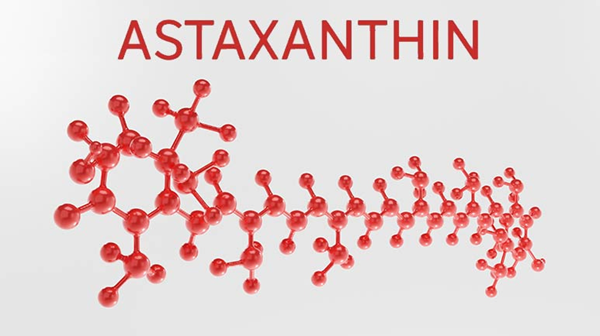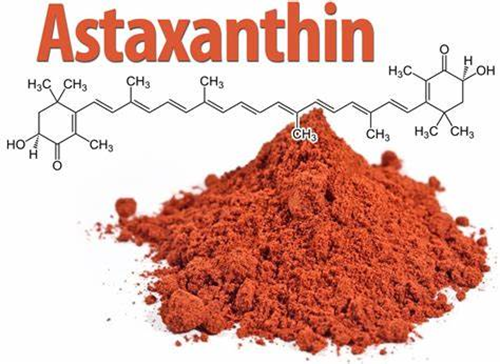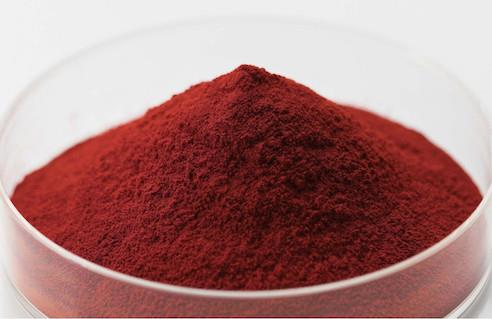Functions and Benefits of Astaxanthin
Astaxanthin is a ketocarotene with strong antioxidant activity, belonging to the lutein class of compounds. It is naturally found in various organisms, such as microalgae, yeast, salmon, trout, shrimp, and crayfish. Its functions are associated with a variety of human health benefits.

Functions of Astaxanthin
(1) Antioxidant Activity: Astaxanthin can reduce the production of reactive oxygen species and increase the levels of superoxide dismutase and catalase.
(2) Anti-inflammatory Effects: Astaxanthin reduces oxidative stress.
(3) Anticancer Effects: Astaxanthin can inhibit cancer cell proliferation, induce apoptosis, and reduce cell invasion to suppress tumorigenesis.
(4) Mitochondrial Function Protection: Astaxanthin can dose-dependently increase MMPs in the heart and reduce mitochondrial release of cytochrome c, thereby inhibiting apoptosis and contractile dysfunction, ultimately improving cardiac function.
Applications and Benefits of Astaxanthin in Diseases
Cardiovascular Diseases
Astaxanthin is considered a potential treatment for cardiovascular diseases. Studies have shown that astaxanthin can reduce the oxidation of low-density lipoprotein (LDL), dose-dependently lower triglyceride levels, and increase serum high-density lipoprotein (HDL) cholesterol and adiponectin levels. Adiponectin is a protein hormone that regulates various metabolic processes, including glucose regulation and fatty acid oxidation. Astaxanthin may help prevent atherosclerosis and cardiovascular disease by regulating LDL and HDL levels, as well as reducing blood pressure, inflammation, and oxidative stress.
Diabetes
Previous studies have shown that astaxanthin can lower blood glucose levels in diabetic db/db mice. In a diabetic rat model, the activities of superoxide dismutase, catalase, glutathione peroxidase, and glutathione reductase in the liver, as well as the level of glutathione, were significantly reduced, and astaxanthin treatment could reverse these changes. Furthermore, diabetes primarily damages tissues such as the kidneys, and astaxanthin can protect cells in diabetic kidneys from damage.
Neurodegenerative Diseases
Astaxanthin can protect neurons from reactive oxygen species-mediated toxic damage by reducing oxidative stress and decrease ischemia/reperfusion-induced loss of hippocampal pyramidal neurons, as well as learning and memory impairment. It has also been shown to inhibit aluminum-induced glial cell activation and reactive oxygen species production, thereby improving spatial memory and motor abilities in aluminum-treated animals. In neuronal cell models and primary hippocampal neurons, astaxanthin can reduce Aβ toxicity by alleviating β-amyloid (Aβ)-induced oxidative stress, and Aβ plays an important role in the pathogenesis of Alzheimer's disease (AD).
Cancer
Astaxanthin has been shown to have anticancer effects. In an in vitro gastric cancer cell model, astaxanthin inhibits cell proliferation through extracellular signal-regulated kinase (ERK)-mediated cell cycle arrest. In liver cancer cells, astaxanthin not only interferes with the cell cycle but also induces apoptosis. In lung cancer cells, astaxanthin enhances apoptosis induced by the chemotherapeutic drug mitomycin C by inhibiting Akt and Rad51 activation. In a hamster oral cancer model, astaxanthin modulates the nuclear factor-κB (NF-κB) and Wnt/β-catenin signaling pathways, leading to apoptosis in buccal pouch cells. This model also showed that astaxanthin inhibits cell proliferation by reducing STAT-3-mediated cyclin D1 levels and increasing p21 expression, and suppresses cell invasion by inhibiting matrix metalloproteinase-2 (MMP-2) expression.
Other Diseases
Studies have also indicated that astaxanthin may be beneficial for many other diseases, such as non-alcoholic fatty liver disease, pulmonary fibrosis, and acute kidney injury. It can inhibit fibrosis by attenuating cellular signaling mediated by the fibroblast cytokine transforming growth factor β1 (TGF-β1). It may also reduce hepatic lipid accumulation and alleviate hepatic autophagy by activating peroxisome proliferator-activated receptor α and inhibiting peroxisome proliferator-activated receptor γ.
References:
[1] WANG J, ZHAO Y. Astaxanthin in Disease Prevention and Treatment[C]. 2017: 0. DOI:10.2991/BBE-17.2017.67.
Related articles And Qustion
See also
Lastest Price from Astaxanthin manufacturers

US $100.00-80.00/Kg2025-11-18
- CAS:
- 472-61-7
- Min. Order:
- 1Kg
- Purity:
- 1%-10%
- Supply Ability:
- tons

US $0.00/kg2025-09-22
- CAS:
- 472-61-7
- Min. Order:
- 1kg
- Purity:
- 99%
- Supply Ability:
- 1000kg





